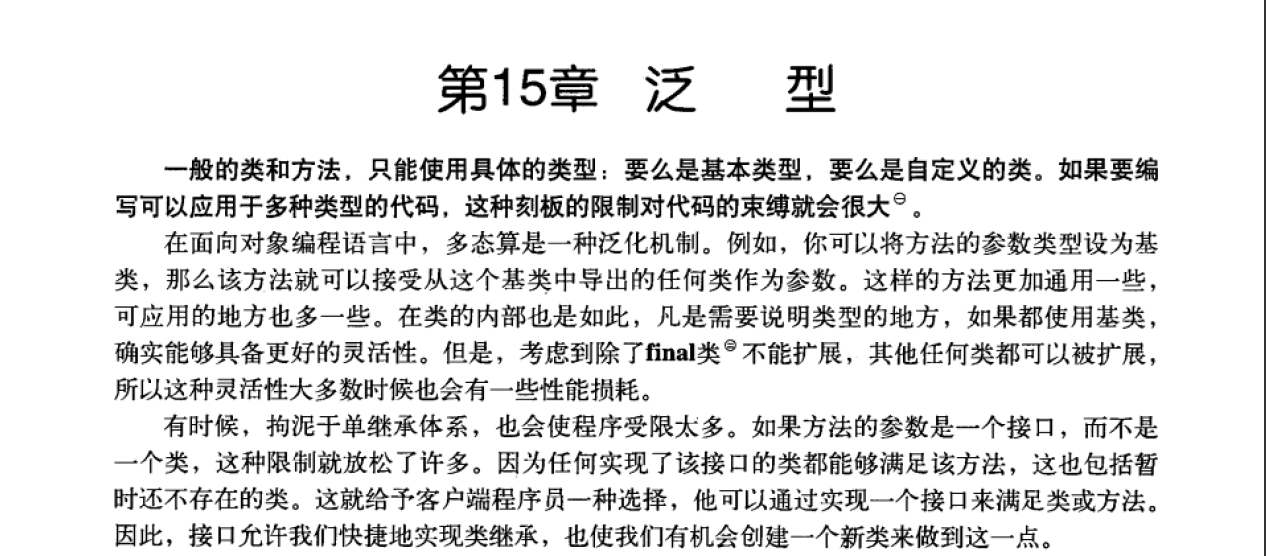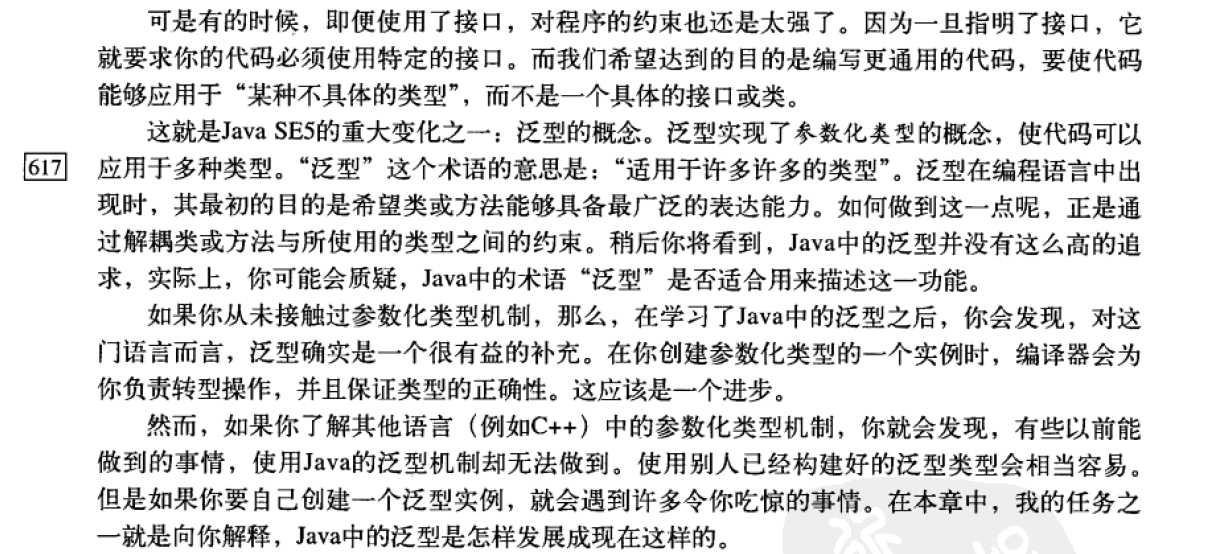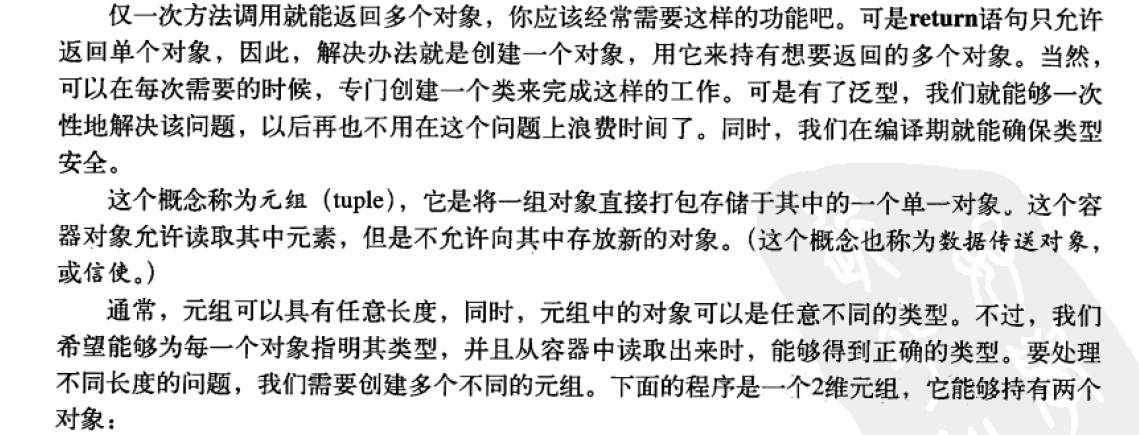-----------------------------------------------------简单泛型--------------------------------------------
public class Holder3<T> {
private T a;
public Holder3(T a) { this.a = a; }
public void set(T a) { this.a = a; }
public T get() { return a; }
public static void main(String[] args) {
Holder3<Automobile> h3 =
new Holder3<Automobile>(new Automobile());
Automobile a = h3.get(); // No cast needed
// h3.set("Not an Automobile"); // Error
// h3.set(1); // Error
}
} ///:~
class Automobile {}
-----------------------------------------元组----------------------------------------------------------
四维元组:
class FourTuple<A,B,C,D>{
public final A first;
public final B second;
public final C third;
public final D fourth;
public FourTuple(A a, B b, C c, D d) {
this.first = a;
this.second = b;
this.third = c;
this.fourth = d;
}
public String toString() {
return "(" + first + ", " + second + ", " +
third + ", " + fourth + ")";
}
}
测试类:
public class TupleTest {
static
FourTuple<Vehicle,Amphibian,String,Integer> h() {
return
new FourTuple<Vehicle,Amphibian,String,Integer>(
new Vehicle(), new Amphibian(), "hi", 47);
}
public static void main(String[] args) {
FourTuple<Vehicle,Amphibian,String,Integer> fourTuple = h();
//fourTuple.third = "sdkfksdfj";// Compile error: final
System.out.println(fourTuple);
}
}
--------------------------------------------------一个堆栈类----------------------------------------------
public class LinkedStack<T> {
private static class Node<U> {
U item;
Node<U> next;
Node() { item = null; next = null; }
Node(U item, Node<U> next) {
this.item = item;
this.next = next;
}
boolean end() { return item == null && next == null; }
}
private Node<T> top = new Node<T>(); // End sentinel
public void push(T item) {
top = new Node<T>(item, top);
}
public T pop() {
T result = top.item;
if(!top.end())
top = top.next;
return result;
}
public static void main(String[] args) {
LinkedStack<String> lss = new LinkedStack<String>();
for(String s : "Phasers on stun!".split(" "))
lss.push(s);
String s;
while((s = lss.pop()) != null)
System.out.println(s);
}
}
-------------------------------------------------------随机取元素工具类-----------------------------------
import java.util.ArrayList;
import java.util.Random;
public class RandomList<T> {
ArrayList<T> list = new ArrayList<T>();
public void add(T item){list.add(item);}
Random random = new Random(47);
public T select(){
return list.get(random.nextInt(list.size()));
}
public static void main(String[] args) {
RandomList<String> list = new RandomList<String>();
String[] ss = "2,3,4,5,6".split(",");
for(int i=0;i<ss.length;i++){
list.add(ss[i]);
}
for(int i=0;i<10;i++){
System.out.println(list.select());
}
}
}
-------------------------------------------------------15.3泛型接口(生成器)--------------------------
1、参数化的 Generator接口
public interface Generator<T> { T next(); }
2、父类以及子类们
public class Coffee {
private static long counter = 0;
private final long id = counter++;
public String toString() {
return getClass().getSimpleName() + " " + id;
}
}
class Americano extends Coffee {}
class Breve extends Coffee {}
class Cappuccino extends Coffee {}
class Latte extends Coffee {}
class Mocha extends Coffee {}
3、生成器类:
import java.util.*;
import net.mindview.util.*;
public class CoffeeGenerator
implements Generator<Coffee>, Iterable<Coffee> {
private Class[] types = { Latte.class, Mocha.class,
Cappuccino.class, Americano.class, Breve.class };
private static Random rand = new Random(47);
public CoffeeGenerator() {}
private int size = 0;//这个是给iterator方法用的
public CoffeeGenerator(int sz) { size = sz; }//这个构造器也是给iterator方法用的
public Coffee next() {
try {
Coffee coffee = (Coffee)
types[rand.nextInt(types.length)].newInstance();
System.out.println("我进来了哦哦哦哦哦");
return coffee;
// Report programmer errors at run time:
} catch(Exception e) {
throw new RuntimeException(e);
}
}
class CoffeeIterator implements Iterator<Coffee> {
int count = size;
public boolean hasNext() { return count > 0; }
public Coffee next() {
count--;
return CoffeeGenerator.this.next();
}
public void remove() { // Not implemented
throw new UnsupportedOperationException();
}
};
public Iterator<Coffee> iterator() {
return new CoffeeIterator();
}
public static void main(String[] args) {
CoffeeGenerator gen = new CoffeeGenerator();
for(int i = 0; i < 5; i++)
System.out.println(gen.next());//这里只是单纯的调用CoffeeGenerator的next()方法,并没有涉及到iterator方法
for(Coffee c : new CoffeeGenerator(9))
//这里的循环自动调用的iterator方法,自动通过iterator方法进行遍历操作(手先增强for循环和iterator遍历的效果是一样的,也
//就说 增强for循环的内部也就是调用iteratoer实现的,但是增强for循环 有些缺点,例如不能在增强循环里动态的删除集合内容。不能获取下标等。)
System.out.println(c);
}
}
以下是我自己模仿list实现的iterator:
import java.util.ArrayList;
import java.util.Iterator;
public class MySelfList<T> {
ArrayList<T> list = new ArrayList<T>();
int size;
public void add(T item){
list.add(item);
size++;
}
public Iterator<T> iterator(){
return new MyIterator();
}
private class MyIterator implements Iterator<T>{
private int count;
private int listSize = size;
@Override
public boolean hasNext() {
// TODO Auto-generated method stub
return count<size;
}
@Override
public T next() {
// TODO Auto-generated method stub
T value = list.get(count);
count++;
return value;
}
@Override
public void remove() {
// TODO Auto-generated method stub
throw new UnsupportedOperationException();
}
}
public static void main(String[] args) {
MySelfList<String> list = new MySelfList<String>();
String[] ss = "1,2,3,4,5,6,7,8,9".split(",");
for(int i=0;i<ss.length;i++){
list.add(ss[i]);
}
Iterator itertor = list.iterator();
while(itertor.hasNext()){
System.out.println(itertor.next());
}
}
}
-----------------------------------------------------------15.4泛型方法-------------------------------------
1、对于一个static方法来说,无法访问泛型类的类型参数,无论是否是泛型方法,比如:
class Animals<T>{
T s;
public static<U> void test(){
//T ss;
U t;
}
public static void test2(){
//T ss;
}
}
这两个方法里面都不允许引用T
所以static方法要使用泛型,必须使其成为泛型方法。
2、成为泛型方法很简单:只需将泛型参数列表置于返回值前,像
public <T> void f(T x) {
System.out.println(x.getClass().getName());
}
这样就可以了哦
3、在泛型方法中利用类型参数推断:这里只是赋值的时候能进行自动的类型参数推断,传递参数的话,还是变成object对象,如下:
import java.util.*;
public class New {
public static <K,V> Map<K,V> map() {
return new HashMap<K,V>();
}
public static <T> List<T> list() {
return new ArrayList<T>();
}
public static void main(String[] args) {
Map<String, List<String>> sls = New.map();
List<String> ls = New.list();
}
}
public class LimitsOfInference {
static void f(Map<Person, List<? extends Pet>> petPeople) {
}
public static void main(String[] args) {
// f(New.map()); // Does not compile//这里是object
}
}
class Person {}
class Pet{}
class Dog extends Pet{}
3.1、如果是传参的话,只能用显示的类型说明:显示的类型用法:(如果是在定义该方法的内部,在点操作符用this关键字,如果是static方法就在点操作符之前加上类名)
public class ExplicitTypeSpecification {
static void f(Map<Person, List<Pet>> petPeople) {}
public static void main(String[] args) {
f(New.<Person, List<Pet>>map());//这里正常自动转型
}
}
4、利用生成器很方便的填充一个collection容器,这在实际中很用用
01、public interface Generator<T> { T next(); }
02、import java.util.*;
public class CoffeeGenerator
implements Generator<Coffee>{
private Class[] types = { Latte.class, Mocha.class,
Cappuccino.class, Americano.class, Breve.class };
private static Random rand = new Random(47);
public CoffeeGenerator() {}
public Coffee next() {
try {
Coffee coffee =
(Coffee) types[rand.nextInt(types.length)].newInstance();
return coffee;
} catch(Exception e) {
throw new RuntimeException(e);
}
}
}
03、public class Coffee {
private static long counter = 0;
private final long id = counter++;
public String toString() {
return getClass().getSimpleName() + " " + id;
}
}
class Americano extends Coffee {}
class Breve extends Coffee {}
class Cappuccino extends Coffee {}
class Latte extends Coffee {}
class Mocha extends Coffee {}
04、import java.util.*;
public class Generators {
public static <T> Collection<T> fill(Collection<T> coll, Generator<T> gen, int n) {
for(int i = 0; i < n; i++)
coll.add(gen.next());
return coll;
}//这个就是填充容器的泛型方法
public static void main(String[] args) {
Collection<Coffee> coffee = fill(new ArrayList<Coffee>(), new CoffeeGenerator(), 4);
for(Coffee c : coffee){
System.out.println(c);
}
}
}
5、一个通用的生成器
01、public interface Generator<T> { T next(); }
02、public class BasicGenerator<T> implements Generator<T> {
private Class<T> type;
public BasicGenerator(Class<T> type){ this.type = type; }
public T next() {
try {
// Assumes type is a public class:
return type.newInstance();
} catch(Exception e) {
throw new RuntimeException(e);
}
}
// Produce a Default generator given a type token:
public static <T> Generator<T> create(Class<T> type) {
return new BasicGenerator<T>(type);
}
}
以下测试的:
03、public class CountedObject {
private static long counter = 0;
private final long id = counter++;
public long id() { return id; }
public String toString() { return "CountedObject " + id;}
}
04、public class BasicGeneratorDemo {
public static void main(String[] args) {
Generator<CountedObject> gen =
BasicGenerator.create(CountedObject.class);
for(int i = 0; i < 5; i++)
System.out.println(gen.next());
}
} /* Output:
CountedObject 0
CountedObject 1
CountedObject 2
CountedObject 3
CountedObject 4
*///:~
6、一个set的实用工具,可以进行像数学里多的集合操作运算:
import java.util.*;
public class Sets {
public static <T> Set<T> union(Set<T> a, Set<T> b) {
Set<T> result = new HashSet<T>(a);
result.addAll(b);
return result;
}//这个是取两个set的合集,因为set的本身不能重复,所以不会达到union all 的效果,数学上称并集
public static <T>
Set<T> intersection(Set<T> a, Set<T> b) {
Set<T> result = new HashSet<T>(a);
result.retainAll(b);
return result;
}//这个是取两个set的交集,数学上称交集
// Subtract subset from superset:
public static <T> Set<T>
difference(Set<T> superset, Set<T> subset) {
Set<T> result = new HashSet<T>(superset);
result.removeAll(subset);
return result;
}//这个是取superset中有的,但是subset中没有的,简单的说就是移除subset包含的元素
// Reflexive--everything not in the intersection:
public static <T> Set<T> complement(Set<T> a, Set<T> b) {
return difference(union(a, b), intersection(a, b));
}//这两个是取两个元素的全部,除了交集部分
}
01、实际应用类:
枚举类:
public enum Watercolors {
ONE,TWO,THREE,FOUR,FIVE
}
应用类:
import java.util.EnumSet;
import java.util.Set;
public class WatercolorSets {
public static void main(String[] args) {
Set<Watercolors> set1 =
EnumSet.range(Watercolors.ONE, Watercolors.THREE);//从一到三的枚举,生成一个set
Set<Watercolors> set2 =
EnumSet.range(Watercolors.TWO, Watercolors.FIVE);
System.out.println("set1: " + set1);
System.out.println("set2: " + set2);
System.out.println("union(set1, set2): " + Sets.union(set1, set2));
Set<Watercolors> subset = Sets.intersection(set1, set2);
System.out.println("intersection(set1, set2): " + subset);
System.out.println("difference(set1, subset): " +
Sets.difference(set1, subset));
System.out.println("difference(set2, subset): " +
Sets.difference(set2, subset));
System.out.println("complement(set1, set2): " +
Sets.complement(set1, set2));
}
}
输出的结果:
set1: [ONE, TWO, THREE]
set2: [TWO, THREE, FOUR, FIVE]
union(set1, set2): [FOUR, TWO, THREE, ONE, FIVE]
intersection(set1, set2): [TWO, THREE]
difference(set1, subset): [ONE]
difference(set2, subset): [FOUR, FIVE]
complement(set1, set2): [FOUR, ONE, FIVE]
02、实际应用类:使用set工具类打印出java.util包中的各种Collection类和各种Map类直接的差异,非常的直观:
import java.lang.reflect.*;
import java.util.*;
public class ContainerMethodDifferences {
static Set<String> methodSet(Class<?> type) {
Set<String> result = new TreeSet<String>();
for(Method m : type.getMethods())
result.add(m.getName());
return result;
}
static void interfaces(Class<?> type) {
System.out.print("Interfaces in " +
type.getSimpleName() + ": ");
List<String> result = new ArrayList<String>();
for(Class<?> c : type.getInterfaces())
result.add(c.getSimpleName());
System.out.println(result);
}
static Set<String> object = methodSet(Object.class);
static { object.add("clone"); }
static void
difference(Class<?> superset, Class<?> subset) {
System.out.print(superset.getSimpleName() +
" extends " + subset.getSimpleName() + ", adds: ");
Set<String> comp = Sets.difference(
methodSet(superset), methodSet(subset));
comp.removeAll(object); // Don't show 'Object' methods
System.out.println(comp);
interfaces(superset);
}
public static void main(String[] args) {
System.out.println("Collection: " +
methodSet(Collection.class));
interfaces(Collection.class);
difference(Set.class, Collection.class);
difference(HashSet.class, Set.class);
difference(LinkedHashSet.class, HashSet.class);
difference(TreeSet.class, Set.class);
difference(List.class, Collection.class);
difference(ArrayList.class, List.class);
difference(LinkedList.class, List.class);
difference(Queue.class, Collection.class);
difference(PriorityQueue.class, Queue.class);
System.out.println("Map: " + methodSet(Map.class));
difference(HashMap.class, Map.class);
difference(LinkedHashMap.class, HashMap.class);
difference(SortedMap.class, Map.class);
difference(TreeMap.class, Map.class);
}
}
-----------------------------------------------------------15.5匿名内部类(泛型)-----------------------
这是一个排队问题的一种实现,包含的是泛型实现的匿名内部类知识
import java.util.*;
import net.mindview.util.*;
class Customer {//顾客
private static long counter = 1;
private final long id = counter++;
private Customer() {}
public String toString() { return "Customer " + id; }
// A method to produce Generator objects:
public static Generator<Customer> generator() {
return new Generator<Customer>() {
public Customer next() { return new Customer(); }
};
}
}
class Teller {//出纳员
private static long counter = 1;
private final long id = counter++;
private Teller() {}
public String toString() { return "Teller " + id; }
// A single Generator object:
public static Generator<Teller> generator =
new Generator<Teller>() {
public Teller next() { return new Teller(); }
};
}
public class BankTeller {//银行柜员
public static void serve(Teller t, Customer c) {
System.out.println(t + " serves " + c);
}
public static void main(String[] args) {
Random rand = new Random(47);
Queue<Customer> line = new LinkedList<Customer>();
Generators.fill(line, Customer.generator(), 15);
List<Teller> tellers = new ArrayList<Teller>();
Generators.fill(tellers, Teller.generator, 4);
for(Customer c : line)
serve(tellers.get(rand.nextInt(tellers.size())), c);
}
}
-----------------------------------------------------------15.5构建复杂模型(泛型)--------------------
这个事例展示了使用泛型类型来构建复杂模型,是多么的简单。即使每个类都是作为一个构建块创建的,但是其整个还是包含许多部分,这里构建的模型是一个零售店,它包含走廊、货架、商品
import java.util.*;
import net.mindview.util.*;
class Product {//产品
private final int id;
private String description;
private double price;
public Product(int IDnumber, String descr, double price){
id = IDnumber;
description = descr;
this.price = price;
System.out.println(toString());
}
public String toString() {
return id + ": " + description + ", price: $" + price;
}
public void priceChange(double change) {
price += change;
}
public static Generator<Product> generator =
new Generator<Product>() {
private Random rand = new Random(47);
public Product next() {
return new Product(rand.nextInt(1000), "Test",
Math.round(rand.nextDouble() * 1000.0) + 0.99);
}
};
}
class Shelf extends ArrayList<Product> {// 英 [ʃelf] 美 [ʃɛlf] n. 架子;搁板
public Shelf(int nProducts) {
Generators.fill(this, Product.generator, nProducts);
}
}
class Aisle extends ArrayList<Shelf> {//英 [aɪl] 美 [aɪl]n. 通道,走道
public Aisle(int nShelves, int nProducts) {
for(int i = 0; i < nShelves; i++)
add(new Shelf(nProducts));
}
}
class CheckoutStand {}//checkout stand 结账台,收款处
class Office {}//办公室
public class Store extends ArrayList<Aisle> {// 英 [stɔː] 美 [stɔr] n.商店
private ArrayList<CheckoutStand> checkouts =
new ArrayList<CheckoutStand>();
private Office office = new Office();
public Store(int nAisles, int nShelves, int nProducts) {
for(int i = 0; i < nAisles; i++)
add(new Aisle(nShelves, nProducts));
}
public String toString() {
StringBuilder result = new StringBuilder();
for(Aisle a : this)
for(Shelf s : a)
for(Product p : s) {
result.append(p);
result.append("\n");
}
return result.toString();
}
public static void main(String[] args) {
System.out.println(new Store(14, 5, 10));
}
}





























 131
131











 被折叠的 条评论
为什么被折叠?
被折叠的 条评论
为什么被折叠?








